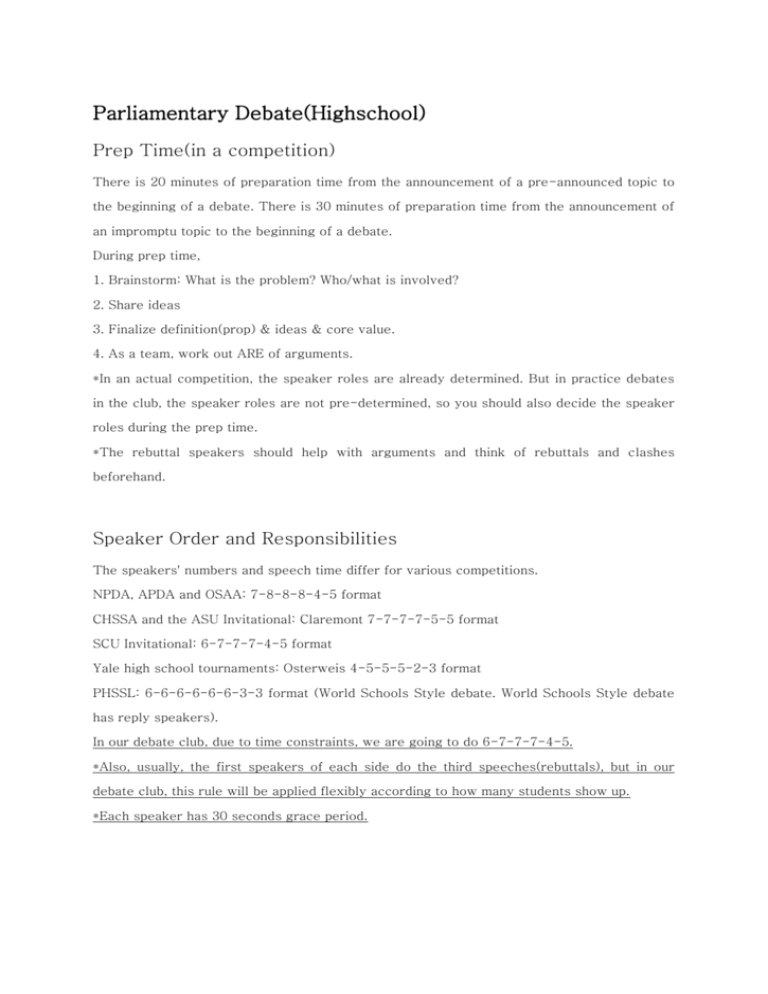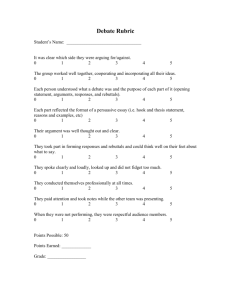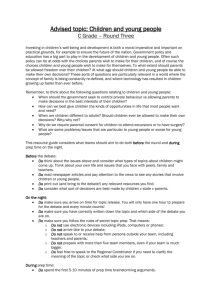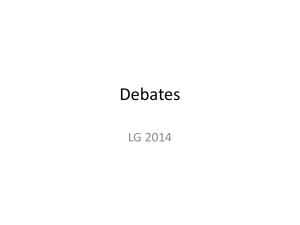File
advertisement

Parliamentary Debate(Highschool) Prep Time(in a competition) There is 20 minutes of preparation time from the announcement of a pre-announced topic to the beginning of a debate. There is 30 minutes of preparation time from the announcement of an impromptu topic to the beginning of a debate. During prep time, 1. Brainstorm: What is the problem? Who/what is involved? 2. Share ideas 3. Finalize definition(prop) & ideas & core value. 4. As a team, work out ARE of arguments. *In an actual competition, the speaker roles are already determined. But in practice debates in the club, the speaker roles are not pre-determined, so you should also decide the speaker roles during the prep time. *The rebuttal speakers should help with arguments and think of rebuttals and clashes beforehand. Speaker Order and Responsibilities The speakers' numbers and speech time differ for various competitions. NPDA, APDA and OSAA: 7-8-8-8-4-5 format CHSSA and the ASU Invitational: Claremont 7-7-7-7-5-5 format SCU Invitational: 6-7-7-7-4-5 format Yale high school tournaments: Osterweis 4-5-5-5-2-3 format PHSSL: 6-6-6-6-6-6-3-3 format (World Schools Style debate. World Schools Style debate has reply speakers). In our debate club, due to time constraints, we are going to do 6-7-7-7-4-5. *Also, usually, the first speakers of each side do the third speeches(rebuttals), but in our debate club, this rule will be applied flexibly according to how many students show up. *Each speaker has 30 seconds grace period. -Prime Minister Constructive(PMC) – 6 minutes This speaker makes a case for the motion for debate, providing a proof of the topic with some major arguments. 1. Explain the background for the motion: status quo, historical background. 2. Define the motion: clarify any obscure terms; set a model if necessary; in a policy debate, explain the policy that the prop is going to follow. 3. State the core value. 4. Explain the team split. 5. Build a constructive case. (ARE) usually two arguments. 6. If have time left, sum up the speech. -Leader of Opposition Constructive(LOC) – 7 minutes This speaker makes several arguments against the proposition team’s case and refutes the proposition’s major points. 1. If disagree with prop's definition of the motion, state it and come up with a definition that the opp will follow. This is not encouraged, though, unless the prop's definition is real nonsense. 2. In a policy debate, LOC can come up with an alternative policy. You're saying that your alternative is better than the policy that prop is proposing. 3. Make rebuttals to the previous speaker. 4. Explain the team split. 5. Build a constructive case. (ARE). usually two arguments. 6. If have time left, sum up. -Member of the Government Constructive(MGC) – 7 minutes This speaker should rebuild and extend upon the proposition’s case. This means that this speaker must defend and amplify the original proposition points and refute the opposition’s major arguments. 1. Make rebuttals to the previous speaker. 2. Build a constructive case. (ARE). usually one or two new arguments. 3. If have time left, sum up. -Member of the Opposition Constructive(MOC) – 7 minutes This speaker amplifies the opposition arguments against the case, providing new information about why the opposition team should win the debate. This speaker should answer the proposition’s answers to the opposition team’s original arguments. 1. Rebuttals to both or either the PMC or MGC. 2. Build a constructive case. (ARE). usually one or two new arguments. 3. If have time left, sum up. -Leader of Opposition Rebuttal(LOR) – 4 minutes This speaker must put the debate together and explain why, given one or more arguments in the debate, the opposition team should win the debate. This speaker accounts for or refutes the proposition’s major points. 1. Give a brief summary of the entire debate(2~3 sentences) 2. For the rebuttals that cannot be included in the clash(see below), say them now. 3. Present clashes/ major questions. Usually two or three clashes/questions. For each clash/question, summarize the prop and the opp's case and why the opp has won the clash. You can rebut the prop inside the clashes. -Prime Minister Rebuttal(PMR) – 5 minutes This speaker should summarize the issues in the debate and explain why, even with the opposition’s arguments, the proposition teams should win the debate. 1. Give a brief summary of the entire debate.(2~3 sentences) 2. For the rebuttals that cannot be included in the clash, say them now. 3. Present clashes/major questions. Usually two or three clashes/questions. For each clash/question, summarize the prop and the opp's case and why the opp has won the clash. You can rebut the prop inside the clashes. Points of Information(POI) Points of information are raised during the speech of the person questioned. The point of information is a brief rejoinder (fifteen seconds or less) to the point then being made by the person speaking. It may be a concise statement or a pointed question. A point of information is also sometimes used for purposes of clarification. Unlike the point of order or personal privilege, the point of information is directed to the person speaking rather than to the Speaker of the House. To make a point of information, the debater rises, faces the person speaking and signals his or her desire to speak. either verbally (saying, for example, "Point of information, Madame/Mr. Speaker!" or "And on that point, Madame/Mr. Speaker") or nonverbally, by holding a hand out. The person speaking may then allow the point to be stated or refuse to take the point. If the person speaking declines your point, you must sit down. If recognized, you make the point and then sit down. The speaker then responds to the point and continues her or his speech. Points of information are not permitted during rebuttals. Nor are they allowed during the first or last minute of any constructive speech. The timekeeper should offer a signal (using a bell or a knock on the table, for example) at the end of the first minute and at the beginning of the last minute of each constructive speech. Points of information are permitted only between these two signals. Point of Order One may rise to a point of order when a member of the other team has violated the rules for debating. There are few rules in parliamentary debate, so a point of order is usually called only when (1) an opponent has introduced a new argument in rebuttals or (2) an Opponent has gone significantly Overtime. A point of order is addressed to the Speaker of the House. The person making the point rises from his or her seat, interrupts the person speaking, saying, "Madame/Mr. Speaker, I rise to a point of order," and then states the violation. The clock is stopped while the point of order is under consideration. In most parliamentary competition, a point of order is not debatable; the Opposing team is not permitted to comment upon it. The Speaker of the House rules immediately upon the completion of the point and says, "Point well taken," "point not well taken," or "point taken under consideration," if no immediate ruling is possible. The Speaker of the House may take the results of the point of order into account in their deliberations, penalizing the team or speaker that has committed the violation. ARE(Constructive Speakers) Assertion: main argument. 1~2 sentences. Reason: logic behind the assertion. Evidence: specific examples. data/statistics. --> At the end of each ARE, make a connection as to why the evidence supports the reason. Clashes(Rebuttal Speakers) -Take the form of versus or question. ex) Freedom of speech vs government censorship. Is there a moral justification for the motion? -Usually two or three clashes. ex) if the motion is "THW censor gangsta rap", possible three clashes could be: 1. Is there a need(moral justification)? gov's responsitiblity vs freedom of expression 2. Is there a practicality?: The policy will work vs it's ineffective 3. What are the results? Is there more good or more harm? -There are many different ways you can form the clashes, but one possible structure could be: Summarizing your team's points --> summarizing the opposing team's points -->summarizing your team's rebuttals to the opp & adding new rebuttals Core Value The core value, also called teamline or caseline, is your team's philosophy, idea, ad thought. It should be general, universal, and comprehensive. The PMC and LOC should definitely state their team's core value, and it is encouraged for the rest of the speakers to state the core value as well. ex) We believe that schools should help students become better adults in the future. A good adult has ~ characteristics. ex) We believe that a political system should serve the citizens and protect their rights. Motion types -THW: policy debate. need a policy/model to follow. can talk about practicality. ex) THW ban smoking, THW ban zoos -THBT: value debate. what should our values be and why? a policy/model is not necessary. practicality shouldn't matter. ex) THBT child labor is justified in developing countries, THBT we should have more freedom. -THBT: factual debate. Is it or is it not the case? Did it or did it not happen? ex)THBT Germany is to blame for WWII, THBT our education system is a failure.







